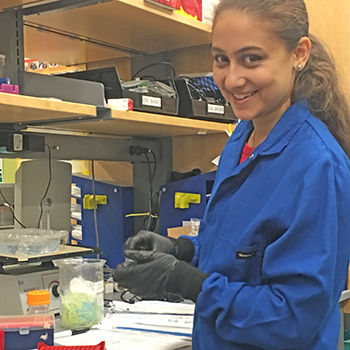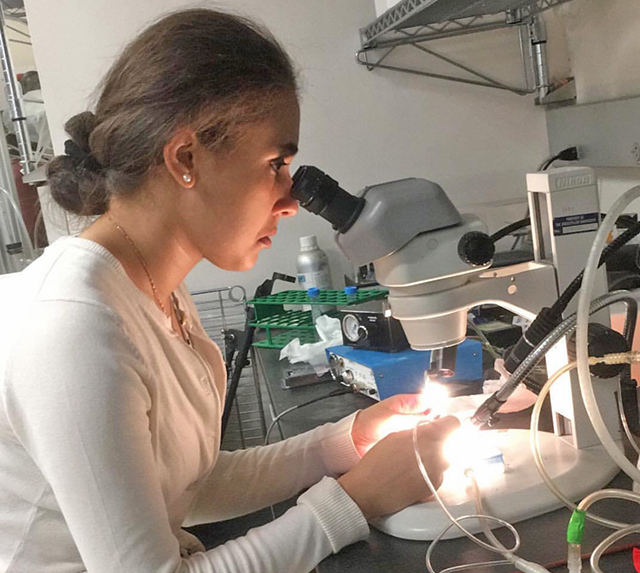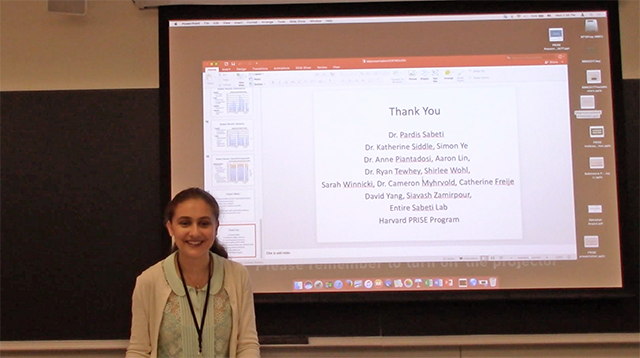 Name: Nadine Khoury
Name: Nadine Khoury
Class: 2020
Concentrations: Bioengineering and computer science
Hometown: Brooklyn, N.Y.
Internship focus: Computational genetics research
Internship locations:
Summer 2018:
Rockefeller University Laboratory of Genetics, headed by Michael Young (New York)
Summer 2017:
Broad Institute of MIT and Harvard, Infectious Disease Computational Genetics Lab, headed by Pardis Sabeti (Cambridge),through Harvard PRISE Fellowship (Program for Research in Science and Engineering)
Describe your internship.
At Rockefeller University, I used fruit flies to explore the relationship between circadian rhythms and the permeability of the blood-brain barrier (which helps filter the passage of substances into the brain). While it was recently discovered that the blood-brain barrier’s permeability varies rhythmically with the sleep cycle, the specific mechanism remains elusive. My project entailed conducting a “screen” to isolate the genes, proteins, and overall mechanism that linked the opening of the blood-brain barrier with the “period” proteins in charge of the circadian rhythm, with the hope of potentially answering a key question: Why do we sleep?
In the Broad Institute, I worked with other researchers on a project to improve DNA sequencing for infectious pathogens using the innovative gene-editing technology CRISPR-Cas9. Recent innovations in the field of computational genetics attempt to diagnose infections genetically by extracting and sequencing genes from patients’ blood samples. However, in a human sample, a viral strain is present in nearly undetectable quantities inside of a pool of the host’s genetic information. My research aimed to remove genetic noise to increase the proportion of an unknown virus’ genetic material in a sample, allowing for a deeper viral sequencing yield. I pursued this “depletion” by harnessing the power of CRISPR-Cas9, a groundbreaking innovation that allows scientists to target and cut specific, custom sites in the genome. I then integrated the power of computer science to interpret the sequencing results. Beginning with a sea of millions of genetic sequencing reads, I located key sequences of the viral genome, identifying close relatives of these viral sequences, and counting them all in order to conclude the effectiveness of the depletion.

What is one of the most valuable lessons you learned from this internship, and why?
These research experiences have taught me the importance of trial and error. Results don’t come right after the first trial. You need to repeat and find the gaps in your work. You need to be very patient; don’t get discouraged and do not give up.
What is one of the biggest challenges you faced during this internship, and why? How did you overcome it?
The biggest challenges I face in the labs often involve experiments that have a different result than expected. While sometimes this results is an exciting new phenotype or genetic signal, oftentimes mechanisms that you thought would lead to a substantial result end up resulting in a null outcome. This can be discouraging because an approach you may have been confident in and spent time developing can leave you clueless and send you back to the drawing board. I vividly remember this occurring at the Broad Institute, where my mentor and I would digest a DNA sample with Cas9, only to find no DNA at all; even after weeks of obtaining this result, it made no sense, the DNA just seemed to vanish from the sample out of thin air.
The way I’ve overcome these roadblocks is two-fold: I read more literature surrounding the topic, and, most importantly, I talk to other researchers who may not be involved in the project. Oftentimes, focusing on one problem for so long can put you in a box, leaving you blindsided to problems that seem apparent to someone with a wider perspective or different research approach. In the case of the “disappearing DNA” conundrum, it was a matter of a colleague pointing out that we should be using a different qPCR dye, a rather trivial issue relative to the more complicated problems that could arise while using CRISPR.

What skills from your courses at SEAS helped you the most during this internship, and why?
My courses at SEAS have greatly benefited me in my research endeavors, by embedding within me the seeds of tenacity, collaboration, endurance, focus, and a meticulous “trial and error” methodology. Just working with classmates on the latest problem-set employs many of the skills I use on a daily basis in lab. My peers and I stick together and feed off of each other, realizing that everyone has a unique perspective to bring to the table. Whether integrating physics, vascular physiology, and Matlab code in Quantitative Physiology as a Basis for Bioengineering (ES 53), or building a “Classroom-Connect” study group website for my Introduction to Computer Science (CS50) project, I’ve learned that the most impactful results come from a strong work ethic, the ability to ask questions, and the willingness to hear and work with a multitude of diverse perspectives.
Why has this internship been a good experience for you?
These experiences have strengthened my sense of collaboration, strategy, and exploration. I’ve learned to think outside of the box, and methodically approach convoluted problems from multiple different perspectives, a skill that is valuable both inside and outside the laboratory.
My experience at the Sabeti Lab has given me the opportunity to synthesize my passion for biology, technology, and computer science, while collaborating with researchers of a diverse range of academic backgrounds.
Furthermore, at the Young Lab, working with live flies, crossing and selecting them, dissecting their brains to measure ion concentrations and neural activity, and analyzing their sleep patterns was a new and fascinating experience that broadened my horizons on genetic research.

How do you think this experience could inform or benefit your future career path?
My research experience helped crystallize the way I approach problems on a fundamental level. To formulate hypotheses and design a methodic plan to isolate the desired result is a problem-solving skill that will benefit any future career path I pursue.
Moreover, the ability to communicate and work with a diverse range of individuals is a fundamental skill that is imperative in the increasingly globalized scientific world I hope to join.
Furthermore, the ongoing innovations in genetics are growing exponentially due to the integration of computer science and innovative technology. While we have taken strides in the ability to quickly sift through a sea of genetic information and find patterns, there are many doors yet to be opened that have the potential to change the way we understand diseases, therapies, and conditions. My research experiences offered me first-hand exposure to this booming field that I wish to pursue in the future with the hopes of creating a positive impact on human life.
These past two summers have been once in a lifetime opportunities. To conduct groundbreaking research in two of the world’s best institutions has been an honor, and to work with such devoted and intelligent people has defined my time at Harvard and beyond.
How did you find out about this internship?
I found out about PRISE through a presentation given during Harvard’s undergraduate research week. I was instantly drawn to the idea of living in a residential “research village,” where undergraduates in fields from pure math, to political science, to biology, can live together and create a fun but intellectual environment over the summer. I was drawn to the lab of Pardis Sabeti through her course, An Integrated Introduction to the Life Sciences: Genetics, Genomics, and Evolution (LS 1b). I was fascinated during office hours when she discussed her work in the computational genetics of infectious diseases and its monumental impact on global health. I was particularly drawn to how the lab implemented its developments in the fields of West Africa during the Ebola outbreak. The project appealed to my interest in international affairs and culture and is a testament to how scientific progress is a global effort.
LS 1b also led me to my experience at Rockefeller University. During the very first lecture, I learned about biological clocks and the fascinating regulatory system featuring the “timeless” and “period” proteins, processes that were discovered by Rockefeller’s Laboratory of Genetics. The initial fascination I gained for genetics in this lecture ignited my passion in the field, and thus motivated me to pursue a summer position at Dr. Young’s lab, with the added benefit of staying in my hometown (New York City) with my family for the summer.